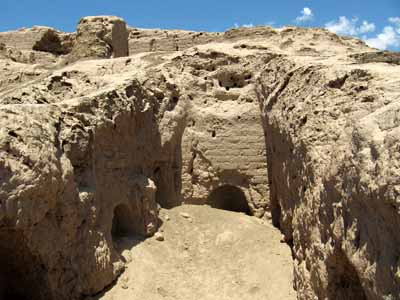After viewing the
Summer Mosque in Khiva I wandered outside the city walls and soon found myself in front of the statue of Abū ʿAbdallāh Muḥammad ibn Mūsā al-Khwārizmī (c. 780–c. 859). Sources vary on the birthplace of al-Khwārizmī, but at least one historian, Ibn al-Nadim, asserts that he was born in Khorezm (also known as Khwarizm), and local boosters insist that despite all the various nay-sayers he was born right here in Khiva, hence his statute here on the main drag in front of the city walls.
Al-Khwārizmī was a celebrated geographer, astronomer and mathematician and is acknowledged as the inventor of
Algebra, a dubious accomplishment which has earned him the well-deserved opprobrium of generations of high school students the world over.
Statue of Abū ʿAbdallāh Muḥammad ibn Mūsā al-Khwārizmī (c. 780–c. 859)
Al-Khwarizmi's most famous (or perhaps most notorious) book, in which he formulated the basis principles of algebra, was entitled Hisab Al-Jabr W'al Mugabalah, translating roughly as "the science of reunion and reduction”.
A page from al-Khwārizmī's Hisab Al-Jabr W'al Mugabalah
Our current word
algebra is
indeed a corruption of the word “Al-Jabr
” in the title. This book is still in print for the benefit of those few interested in such folderol:
The Book of Algebra.
I myself have no interest whatsoever in wasting any more of my time discussing anything so jejune as algebra; if you are really interesting in this subject and have nothing better to do see
A History of Algebra: From Al-Khwarizmi to Emmy Noether and/or
Al-Khwarizmi: The Inventor of Algebra.
On a more salubrious note, later translations into Latin of al-Khwārizmī's other books, notably
On the Calculation with Hindu Numerals (c. 825), led to the introduction of the so-called
Hindu-Arabic Numeral System (complete with a decimal point and the all-important value of zero), and “
Arabic Numerals” (i.e., the numbers we now use), into the Occidental world. Otherwise we would probably still be hammering Roman numerals into granite with a chisel. So al-Khwārizmī did have his redeeming qualities.
In any case, al-Khwārizmī eventually washed up in Baghdad, where he became an integral part of the so-called
Bayt al-Hikmah, or House of Wisdom, an institute of advanced studies in various sciences which had sprung up during the time of Abbasid caliph Harun al-Rashid, he of
One Thousand and One Arabian Nights
fame, and eventually flowered under the patronage of his son al-Mamun (r 813–833 AD).
Indeed, I have just recently added
The House of Wisdom to my Scriptorium and even more fortuitously a
Review has just appeared in the
New Year Times:
Abdullah al-Mamun, caliph of Baghdad in the early 9th century, was indispensable to this intellectual flowering. The city was only four decades old but had already become the largest in the world. In this vibrant setting, al-Mamun established an institute, the House of Wisdom, the likes of which had not been seen since the great library at Alexandria. The author compares Baghdad in those days to Renaissance Florence or Athens in the age of Pericles. At first, the caliph followed his great-grandfather’s practice of pushing his savants for Arabic translations of Greek books in the country’s possession, a legacy of Hellenistic rule for several centuries after the conquests of Alexander the Great. Over the next two centuries, more works of Aristotle, Pythagoras, Archimedes and Hippocrates, as well as Persian and Indian thinkers, were rendered into Arabic. It became a lucrative business, abetted by advances in papermaking learned from captive Chinese soldiers. Other wealthy patrons, not only the caliph, supported the translation movement, al-Khalili points out, “in part for the practical benefits it brought them in finance, agriculture, engineering projects and medicine, and in part because this patronage quickly turned into a de rigueur cultural activity that defined their standing in society.” A modern budget proposal from a science-funding agency could not have put it better.
The
Bayt al-Hikmah has now been recreated in cyperspace. See
The House of Wisdom, a blog about the latest developments in Arabic science.
Stamp commemorating al-Khwārizmī's 1200th birthday. Al-Khwārizmī also has An Area On The Moon named after him.
 ” fame, is probably the world’s oldest “revealed” religion, and as such Zoroastrians are even regarded as “People of the Book”, along with Christians and Jews, by at least some Muslims (sorry, Buddhists remain garden-variety Idolators). The major premise of Zoroastrianism, as you no doubt know, is the vast cosmic struggle between Ahura Mazdah, the God of Light (very roughly speaking), and Ahriman, the principal of Darkness and Evil. Zoroastrianism was very widespread in the Transoxiania and Khorezm regions before the arrival of the Islam in the eight and ninth centuries. For an utterly titillating account of Zoroastrianism see In Search of Zarathustra
” fame, is probably the world’s oldest “revealed” religion, and as such Zoroastrians are even regarded as “People of the Book”, along with Christians and Jews, by at least some Muslims (sorry, Buddhists remain garden-variety Idolators). The major premise of Zoroastrianism, as you no doubt know, is the vast cosmic struggle between Ahura Mazdah, the God of Light (very roughly speaking), and Ahriman, the principal of Darkness and Evil. Zoroastrianism was very widespread in the Transoxiania and Khorezm regions before the arrival of the Islam in the eight and ninth centuries. For an utterly titillating account of Zoroastrianism see In Search of Zarathustra . For still more see Magi
. For still more see Magi .
. 









































